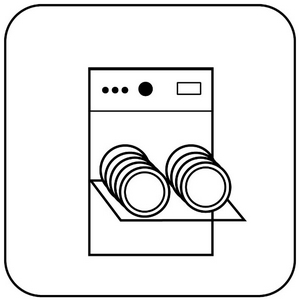Rinsing

Please do not assume that you can read how to wash porcelain "properly" on this page. We will shorten this section by saying: Please follow the instructions provided by the dishwasher manufacturer and the relevant detergent. This section of our product information refers to the "problem areas" of dishwashing that no crockery manufacturer really wants to address. Hardly any other process in the kitchen is as controversial, misunderstood and intertwined with so many different causes as dishwashing. We explain many of the associated factors in our articles on solid residues, scratches, cutlery abrasion and washing loads.
Definition of cleaning
The porcelain must be cleaned properly after use. In German, we refer to cleaning with water and liquids as "Spülen", call the corresponding appliance a "Spülmaschine" and mechanical washing aids a "Spülbürste" or "Spülschwamm".
Why does flushing have so many points of contention?
As is well known, disputes arise when people disagree. Disagreement prevails when different views and opinions clash on a matter, a development or on results. We regularly find this circumstance in the application area of dishwashing. The following causes or results are then usually present.
- broken edges
- broken handles
- abraded surfaces
- breakage of the porcelain
- water residues
- discoloration
- bacterial contamination
The cause is usually the result, namely the porcelain that has been affected. Especially from the consumer's point of view, it is often only due to the "bad porcelain" if one of the above mentioned circumstances occurs. Too often "porcelain" is said, but stoneware or imitation porcelain is meant, because the differences between these types of goods are not apparent to the consumer.
Before, during and after the dishwashing process, the dishes are exposed to a variety of stresses and strains that have very different effects and can be assigned to different participants in the washing process.
- mechanical load during the rinsing process
- mechanical load by the water
- thermal load
- mechanical pre-damage
- chemical exposure to detergents
- biochemical reactions by the environment
- contamination by water and detergent
In all these processes, the defective results are not the result of poor quality porcelain.
Dishwasher resistant or dishwasher suitable?
Dishwasher resistance or dishwasher suitability are obsolete suitability characteristics and describe the degree of durability that a piece of crockery can withstand through the "dishwasher" cleaning process, in particular a diffuse definition left to the manufacturer that is hardly verifiable, with an appended "if and but". The following designations were customary in the industry.
- "dishwasher resistant" (= it lasts)
- "dishwasher suitable" (= it does not last or not very long)
- "no specification" (= it is defenitively not suited for a dishwasher)
As a rule, the type of crockery and/or its decoration determined the degree of suitability or dishwasher suitability. White hard porcelain (without decoration) is always dishwasher safe, as there are no finishes that are subject to the risk of abrasion; this type of cullet always withstands the usual chemical stresses.
The type and quality of the glaze and the thickness of the body (thickness of the porcelain) determine resistance to mechanical and thermal stress.
The basic rule was that inglazes and underglazes are always dishwasher safe. On-glazes, on the other hand, were considered dishwasher-safe and should rather be cleaned by hand. Only porcelain was considered to be permanently dishwasher safe. Ceramics, stoneware or porcelain stoneware were not. The more beautiful and elaborate a decoration, the more likely the dishes are not dishwasher safe! Decors with precious metals, i.e. gold and platinum finishes are usually not dishwasher safe at all. The colors bright red and sunflower yellow are usually indicators for onglazes, i.e. decorations that are not dishwasher safe. Even the use of so-called protective lacquers is not a permanent protection for bright finishes.
We repeat these "outdated rules of thumb" because they are still valid in the quality assessment of tableware - despite the EU.
Dishwasher resistance
The European Union has already eliminated the above mentioned terms for porcelain and tableware made of non-metallic materials in 2005 and introduced fixed definitions. The term "resistance" is now used to indicate strength or suitability and, in accordance with DIN EN 12875-1, requires the specification of guaranteed washing processes. The criteria of dishwasher resistance are also firmly defined.
- gloss of the glaze
- turbidity of surfaces
- adherent deposits
- iridescent layers
- hairline cracking
- abrasion marks
- color stability of decors
In line with the working methods of the EU, associated standards have been adopted which describe exactly how - where - when - by whom and with what testing must be carried out. The test procedures are defined down to the smallest detail, including water hardness and rinsing water temperature, composition of the detergents and assessment method. Even the strength of the "... from above is 3500 - 4500 K between 1.000 and 1.500 lx...". In order to achieve an indisputable legal validity of an exact dishwasher resistance, an expert's certificate of the luminous intensity in the measuring environment, an ophthalmologic certificate of the expert's vision and a record of the ergonomics of the ambient climate according to ISO/DIS 10551:2017 are required.

Thanks to these EU requirements, we believe that no porcelain manufacturer is now in a position to determine the dishwasher resistance of its products itself. It takes companies like the Research Institute for Inorganic Materials - Glass/Ceramics - GmbH in Höhr-Grenzhausen to present such laboratory test results. These cost a lot of money and naturally increase the price of a piece of tableware considerably.
Valence of a laboratory examination
Okay, let's assume that a manufacturer can prove the number of guaranteed dishwasher resistance by a laboratory test. Let's assume that it is a decorated cup. On the basis of the test result for this cup, the manufacturer now proves the dishwasher resistance of 500 rinsing cycles (according to DIN) for his coffee service. This despite the fact that we know that the parts in a service come from very different production techniques and are even made from different raw materials (isostatic granulate / hubels). Decorative colors are usually also of mineral origin and their strength and durability can vary greatly from production batch to production batch.
These variables cannot actually be standardized, because otherwise every manufacturer would have to have every week and every part of its service laboratory tested. Now, however, a piece of tableware loses its color, and consumers complain about this to their dealer or the manufacturer. How on earth can the consumer prove that this piece of crockery has undergone fewer than 500 wash cycles or that the detergents used and their dosage have always complied with the standard? In the event of damage, the mutually necessary burden of proof cannot be provided by any of the parties involved!
According to the DIN standard, the suitability of a dishwasher resistance starts at 125 rinsing cycles. In our opinion, such a guaranteed commercial unsuitability is of little use to the gastronomer. Depending on the capacity utilization of the business, a piece of crockery would thus be out of warranty after only 42 days if it only runs through the machine three times a day (morning, noon and evening). Well-running businesses, however, achieve many times this. Even a higher guarantee of 500 wash cycles would tire after about half a year and 1,000 wash cycles could not even last a whole year.
Conclusion
For the restaurateur, the value of a guarantee of dishwasher resistance begins, in our opinion, with 5,000 rinses, or better still, 10,000. To demonstrate such a durability, regular laboratory tests would be necessary, each of which would take at least 16 days. Such an attempt to meet the DIN standard would probably be more expensive than the production of the article itself. Damage to the wash ware, which would actually be covered by any guarantees that might be granted, can never be proven by the consumer according to the above reasons. In commercial use, 500, 1,000 or 2,000 guaranteed wash processes do not correspond to "intended use" in our opinion. In gastronomy, porcelain is a tool and not an ornamental object!
This is the reason for our decision to continue to use the terms "dishwasher safe" and "dishwasher safe", which are customary in the industry. Dishwasher-safe" refers to an honest and professionally assessed quality of the porcelain (raw materials and firing), which - if the machine is used properly and the chemicals are dosed correctly - will pass through a minimum of 3,000 damage-free rinsing processes in the commercial dishwasher.
We have been doing this since 1928!
Product knowledge - A request to our readers!
Since 1998, we have been cultivating our product knowledge out of a passion for porcelain and the endeavour to share our knowledge about this beautiful and exciting material. In more than 20 years, our information pages have grown into a free online encyclopaedia of porcelain knowledge and now serve as a helpful reference work for dealers, end customers, vocational schools and even competitors. In times of increasingly important reviews on the Internet, we therefore ask you to write us a small review on Google. This will help us to address topics that have not yet been dealt with and to constantly revise this knowledge database. Thank you very much.

